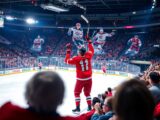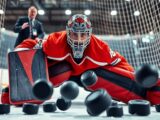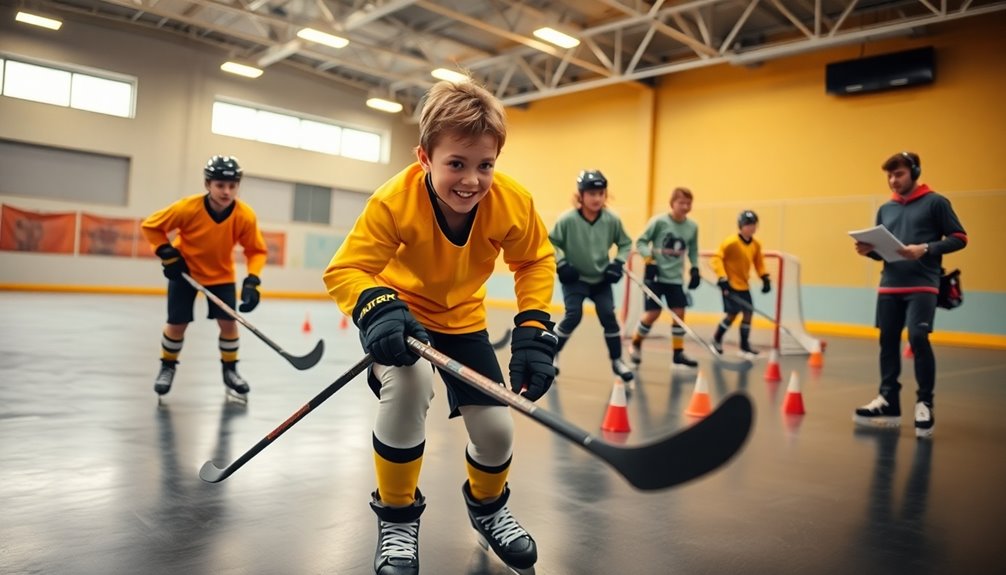
Off-Ice Hockey Training: Techniques to Stay in Shape Year-Round
December 21, 2024Off-ice hockey training is essential for you to stay in shape year-round. Incorporate strength and conditioning exercises like squats and lunges to build skating power. Agility drills, such as ladder workouts, enhance your reaction time and foot speed. Don't forget to focus on flexibility with dynamic stretching to prevent injuries. Pair these with mental training techniques like visualization to improve focus under pressure. A balanced diet and proper recovery guarantee you stay energized and ready to perform. By creating a structured program, you'll continuously see improvements and stay competitive—there's always more to uncover about optimizing your training methods.
Importance of Off-Ice Training
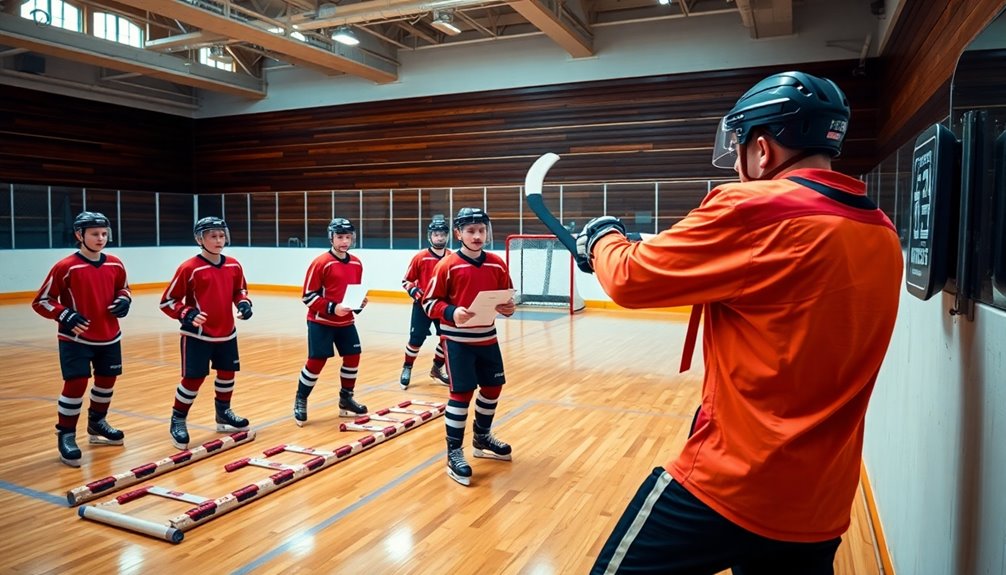
Off-ice training is essential for every hockey player, and it's something you should prioritize regularly. This type of training enhances your overall performance on the ice by developing key attributes like strength, speed, agility, and endurance—traits fundamental for competitive play. Regular endurance training is particularly beneficial for maintaining stamina during games, as athletes often require a strong aerobic base to sustain their energy levels.
When you commit to regular off-ice workouts, you greatly reduce your risk of injury. Improved flexibility and strength lead to better body mechanics during games, allowing you to play at your best.
Moreover, a structured off-ice training program helps you maintain your fitness levels throughout the demanding hockey season, preventing burnout. By incorporating a variety of exercises, such as plyometrics and core stability workouts, you can enhance your balance and coordination, which are essential for effective skating and puck handling.
Consistent off-ice training also fosters mental toughness and resilience, equipping you to handle high-pressure situations on the ice. As you face challenging moments in games, the skills and endurance built during off-ice sessions will give you the edge you need. Additionally, integrating various cardio workouts into your routine can significantly improve your stamina and overall athletic performance.
Prioritizing off-ice training not only prepares your body but also sharpens your mind for the challenges ahead.
Key Components of Off-Ice Training
To elevate your on-ice performance, focusing on flexibility and mobility exercises is essential. Incorporating strength and conditioning routines will build the power you need during games. Additionally, incorporating speed and agility drills will enhance your overall performance and improve your reaction time on the ice. Engaging in pain shuttles drills can significantly boost your endurance and agility, translating to better performance during intense game situations. Combining these workouts with interval training can further simulate the stop-and-go nature of hockey, enhancing your stamina on the ice.
Flexibility and Mobility Exercises
Incorporating flexibility and mobility exercises into your training routine is essential for enhancing your performance on the ice. These exercises, such as dynamic stretching, yoga, and foam rolling, improve your range of motion and reduce the risk of injuries. By committing to a consistent routine of flexibility training, you can enhance your skating mechanics and shooting accuracy, both vital for success in hockey.
Mobility exercises specifically address common imbalances and tightness caused by the repetitive movements in hockey. Research shows that athletes who engage in regular flexibility training can experience a 10-20% improvement in overall athletic performance. This significant boost can give you an edge over your competition.
Dynamic warm-ups that incorporate mobility drills are particularly effective in preparing you for intense training sessions. They help reduce the likelihood of strains and sprains, ensuring you're ready to perform at your best.
Strength and Conditioning Focus
A well-rounded strength and conditioning program is vital for hockey players aiming to elevate their performance on the ice. To achieve this, focus on flexibility, core stability, and explosive power.
Start your off-ice training with dynamic warm-ups to prepare your body for the workout ahead. Incorporate strength training exercises like squats and lunges to build lower body strength, which is essential for skating power.
Plyometric exercises should also be part of your routine. These drills enhance your speed and agility, allowing you to navigate the ice more effectively. Additionally, include mobility and prehabilitation exercises to reduce injury risk and improve your overall movement quality.
Aim for 3-5 workouts per week, concentrating on strength, speed, and conditioning to maintain your fitness throughout the hockey season. Regularly assess your progress and adapt your training regimen to guarantee you're building a solid foundation, especially if you're a youth player.
This structured approach not only prepares you for competitive play but also helps you stay in peak physical condition year-round. Embrace these key components, and you'll see significant improvements on the ice.
Mental Training Techniques
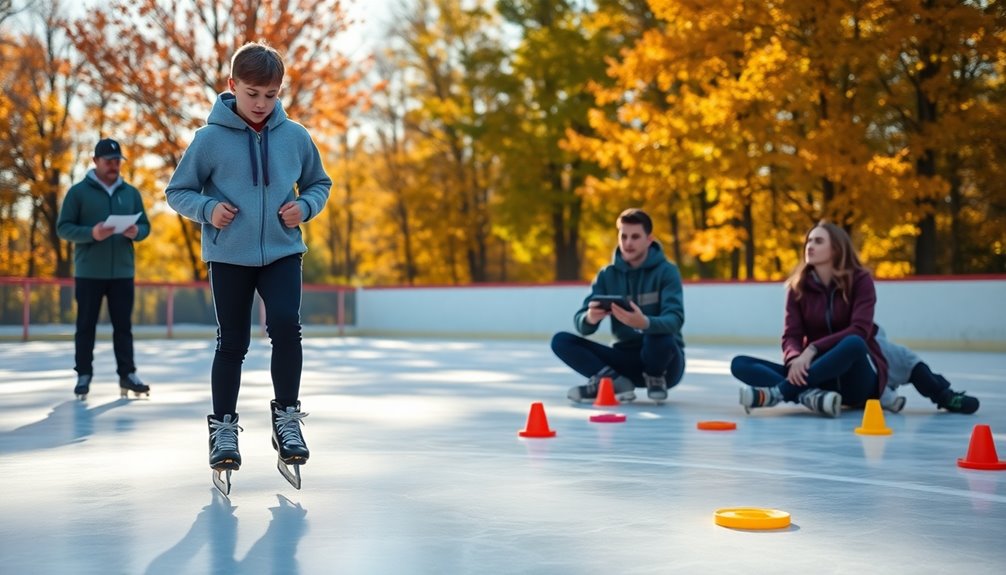
To elevate your game, incorporating mental training techniques is essential.
By using visualization, setting clear goals, and practicing mindfulness, you can enhance your focus and performance on the ice. Additionally, embracing teamwork dynamics can further strengthen your mental resilience and confidence during every game. Moreover, developing mental strength sharpens focus, resilience, and confidence, which are crucial for consistent performance. Furthermore, understanding game intelligence can help you anticipate opponents' moves, allowing you to make quicker decisions and elevate your overall gameplay.
Visualization for Performance Enhancement
Harnessing the power of visualization can greatly elevate your hockey performance. By mentally rehearsing your skills and game scenarios, you can enhance your execution during actual matches. Studies show that athletes who practice visualization can see up to a 15% improvement in performance compared to those who don't.
To effectively use visualization, create vivid mental images of yourself successfully executing skills, like scoring a goal or making a perfect pass. This process activates the same neural pathways as physical practice, reinforcing your abilities. Incorporating visualization into your daily routine for just 10-15 minutes can notably boost your focus and confidence levels before competitions.
Moreover, athletes who engage in visualization often report reduced anxiety and improved mental resilience. This is essential for maintaining composure during critical game situations, allowing you to perform at your best when it matters most.
Goal Setting Strategies
Visualization techniques lay a solid foundation for effective goal setting in your off-ice training. By incorporating structured goal setting, you create clear, measurable objectives that help enhance your focus and motivation. This leads to improved performance on the ice.
Here are four key strategies to optimize your goal setting:
- Define SMART Goals: Guarantee your goals are Specific, Measurable, Achievable, Relevant, and Time-bound to increase your chances of success.
- Set Short-term and Long-term Goals: Balance immediate objectives with overarching aspirations to maintain motivation and track your progress effectively.
- Regularly Review Goals: Periodically assess your goals to adapt to changes and keep your training relevant, which can lead to greater satisfaction.
- Incorporate Visualization: Mentally rehearse achieving your goals to boost your confidence and solidify your commitment to them.
Research shows that athletes who actively engage in goal setting and review their objectives experience significant performance improvements.
Mindfulness and Focus Techniques
A strong mental game is imperative for success in hockey, and mindfulness techniques can greatly enhance your focus and performance. By incorporating practices like meditation and breathing exercises, you can reduce stress and anxiety, allowing you to concentrate better during high-pressure situations.
Visualization techniques also play an important role; they enable you to mentally rehearse different game scenarios, improving both your motor skills and confidence in competitive settings.
Setting clear, achievable goals is another essential aspect of maintaining focus. When you have specific objectives to aim for, your motivation stays high, leading to better performance outcomes. Regular self-assessment helps you reflect on your progress and identify areas for improvement, fostering a growth mindset that's important for long-term development.
Additionally, don't overlook stress management techniques, such as progressive muscle relaxation. These practices can enhance your recovery and mental clarity, ensuring you maintain peak performance throughout the hockey season.
Designing an Off-Ice Program
Creating an effective off-ice hockey training program requires careful consideration of an athlete's unique strengths and areas for improvement.
To design a tailored routine that enhances performance, focus on these key components:
- Assessment: Evaluate your current fitness level and specific needs.
- Balanced Components: Guarantee your program includes flexibility, strength, speed, endurance, and balance. Incorporating specific drills can further enhance your agility and overall performance on the ice. Additionally, utilizing dynamic warm-up routines can prepare your body for intense training sessions and help prevent injuries.
- Training Frequency: Schedule sessions 3-4 times per week for consistent practice and adequate recovery.
- Exercise Variety: Incorporate bodyweight movements, plyometrics, and resistance training for engaging workouts. Additionally, integrating agility training can enhance your movement and reaction time, making you more effective on the ice.
Top Exercises for Key Components
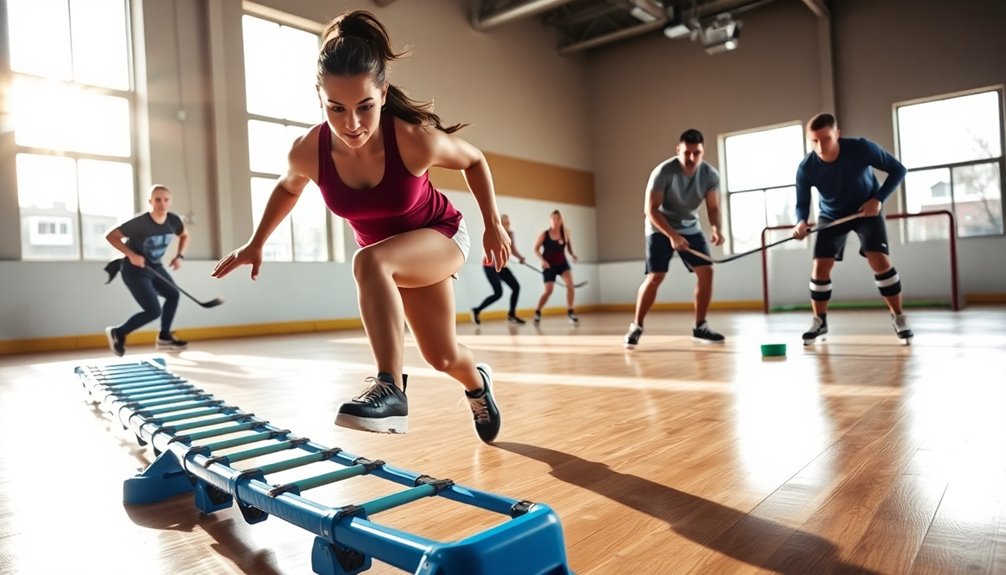
Building a well-rounded off-ice training program hinges on incorporating top exercises that target flexibility, strength, speed, endurance, and balance. For flexibility, start each session with 10-15 minutes of dynamic stretching and foam rolling to enhance your range of motion and minimize injury risk. Regular warm-up routines also help in preparing muscles for play and reducing injury risks.
When it comes to strength, focus on compound movements like squats and lunges. Aim for 3 sets of 8-12 reps to build the functional strength necessary for skating.
Speed training is essential too; incorporate plyometric exercises such as box jumps and sprint drills, performing 3-4 sets of 6-10 reps to develop explosive power and quick acceleration on the ice.
To improve endurance, engage in aerobic activities like running or cycling for 20-30 minutes, 2-3 times a week. This boosts your cardiovascular fitness and stamina, helping you maintain energy during games. Additionally, incorporating high-intensity workouts into your routine can further enhance your conditioning and mimic the demands of actual game scenarios.
Finally, enhance your balance by practicing single-leg drills and core stability exercises, like single-leg deadlifts, with 3 sets of 8-10 reps per leg. Consistent effort in balance training also contributes to overall physical conditioning and performance on the ice.
Integrating Off-Ice and On-Ice Skills
When you integrate off-ice training with your on-ice skills, you'll notice a significant improvement in your skating technique, shooting accuracy, and puck handling.
Practicing drills like stickhandling and shooting on synthetic ice helps simulate real game conditions, making your skills more transferable. Additionally, incorporating tactical awareness into your off-ice drills can enhance your decision-making on the ice.
Skating Technique Practice
To enhance your skating technique, integrating off-ice training with on-ice practice is essential. By focusing on specific off-ice drills, you can greatly improve your overall performance on the ice.
Here are four effective strategies for your skating technique practice:
- Synthetic Ice or Slide Boards: Use these surfaces to enhance your balance and edge control, key components for effective skating.
- Stickhandling Drills: Incorporate stickhandling while skating on synthetic surfaces to develop your puck control and coordination, making on-ice changes smoother.
- Agility Drills: Perform lateral shuffles and quick footwork exercises to mimic explosive movements, improving your skating speed and acceleration during gameplay.
- Resistance Bands: Utilize resistance bands to strengthen the specific muscle groups involved in skating, leading to more powerful strides on the ice.
Regularly monitor your on-ice performance metrics like speed and agility. This way, you can adjust your off-ice training to target areas needing improvement.
Shooting Accuracy Drills
Improving your shooting accuracy is just as important as refining your skating technique. To boost your precision, incorporate off-ice shooting accuracy drills on a synthetic ice surface. This setup mimics the on-ice experience, allowing you to develop skills year-round.
Focus on targeted drills like wrist shots, snapshot variations, and one-timers to enhance specific techniques while receiving immediate feedback on your accuracy.
During your off-ice sessions, use targets placed in the corners of the net. This practice helps you develop consistency and pinpoint precision in your shots.
Don't forget to combine stickhandling with these shooting accuracy drills. This approach simulates game scenarios, increasing your ability to shoot effectively under pressure.
To track your progress, monitor metrics such as accuracy percentage and shot speed during practice. This data will help you identify areas needing improvement and set specific goals for your training.
By integrating these off-ice drills into your routine, you'll not only enhance your shooting accuracy but also elevate your overall performance on the ice.
Puck Handling Skills
Puck handling skills are essential for any hockey player looking to elevate their game, and integrating off-ice training with on-ice practice is a game-changer.
By dedicating time to enhance your puck handling off the ice, you'll see remarkable improvements during games. Here are four key techniques to focus on:
- Stick Handling on Smooth Surfaces: Use your stick on a flat surface or synthetic ice to reinforce muscle memory.
- Dribbling Drills: Incorporate figure-eight and cone weaves to enhance agility and control.
- Weighted Pucks: Train with weighted pucks to build wrist strength and increase shot power.
- Regular Practice: Spend 15-30 minutes a few times a week on specific puck handling drills.
These practices won't only increase your stickhandling speed and accuracy but also boost your confidence in high-pressure scenarios.
As you develop these skills off the ice, you'll notice a smoother shift to on-ice performance, making you a more formidable player against defenders.
Consistency is key, so make off-ice puck handling a regular part of your training routine for the best results!
Monitoring Your Progress
Regularly monitoring your progress is vital for maximizing the benefits of your off-ice hockey training. Start by establishing clear short-term and long-term goals. This way, you can track specific performance metrics like strength gains, speed improvements, and skill development throughout your hockey workouts.
Incorporate regular assessments, such as timed sprints or endurance tests, to measure your progress and evaluate the effectiveness of your training regimen. Keeping a training log is important; document your workouts, exercises completed, and personal bests. This will help you identify trends and pinpoint areas needing improvement over time.
Don't hesitate to solicit feedback from coaches and trainers. Their insights can be invaluable for adjusting your training plan to achieve ideal results.
Celebrate milestones and achievements along the way to maintain your motivation and commitment to your off-ice training goals.
Benefits of Synthetic Ice
Synthetic ice offers hockey players an exceptional training solution, allowing you to practice your skills year-round, no matter the weather.
By incorporating synthetic ice into your training regimen, you can enjoy several benefits:
- Realistic Surface: Synthetic ice provides a skating surface that mimics real ice, helping you maintain your on-ice performance.
- Durability: Its robust nature enables consistent use for shooting, puck handling, and skating drills, so you can develop your skills without needing an ice rink.
- Enhanced Muscle Memory: Repeated practice on synthetic ice improves your technique and muscle memory, essential for executing moves during games.
- Flexibility: Modular synthetic ice can be set up in various locations—be it your home, garage, or outdoor space—making training convenient.
With synthetic ice, you can engage in focused practice sessions that fit your schedule, ensuring that you stay sharp even during the off-season.
The ability to train in a controlled environment means you'll be ready to hit the ice with confidence when the season starts.
Embrace the benefits of synthetic ice, and elevate your game all year long!
Training for Different Player Sizes
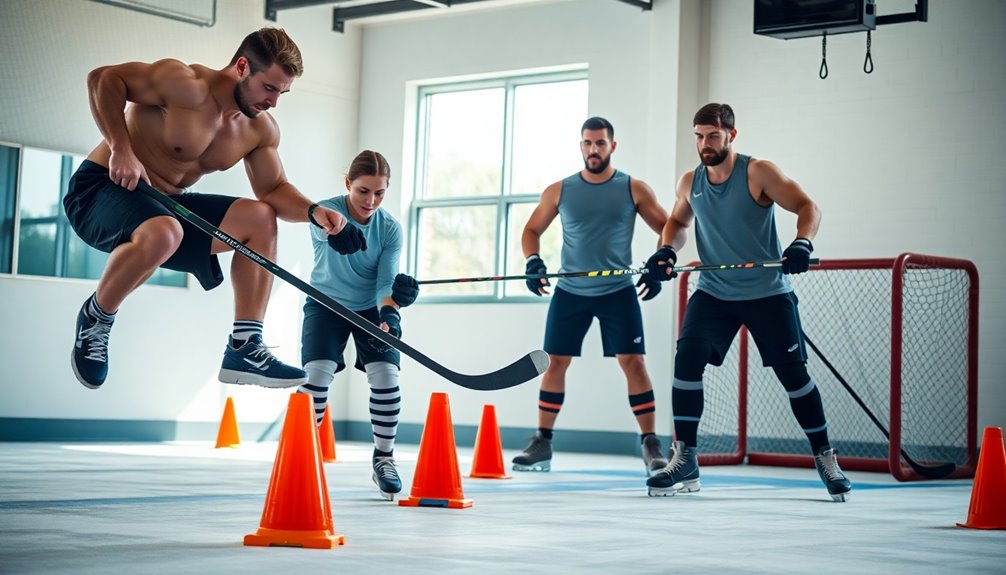
How can you tailor your off-ice training to match your size and maximize your performance? If you're a smaller player, focus on enhancing your agility and speed through plyometric exercises. These drills will help you develop the explosive power necessary for quick movements on the ice.
On the other hand, if you're larger, prioritize strength training that emphasizes lower body power, incorporating squats and deadlifts to improve your skating ability and on-ice presence.
Training for hockey requires you to evaluate your unique physical attributes. Smaller athletes should engage in speed and agility drills, while larger athletes should concentrate on strength and conditioning to leverage their physical advantages.
Don't forget about mobility work—enhanced flexibility aids smaller players in maneuvering around opponents and helps larger players maintain balance and stability during play.
Additionally, incorporate bodyweight exercises and resistance training tailored to your weight class. This approach supports proper muscle development and minimizes the risk of injury, allowing you to train effectively and safely.
Nutrition for Optimal Performance
While off-ice training is essential for honing your skills, nutrition is equally important for enhancing your performance. Proper nutrition fuels your physical and mental capabilities, ensuring you have the energy and focus needed during training and games.
Here are some key points to reflect on for nutrition for peak performance:
- Balanced Diet: Incorporate whole foods like fruits, vegetables, lean proteins, and healthy fats. These provide essential nutrients for peak athletic performance.
- Hydration: Aim for at least 8 cups (64 ounces) of water daily, increasing your intake on workout days to prevent dehydration and maintain performance.
- Post-Workout Recovery: Consume a combination of carbohydrates and protein in a 3:1 ratio after workouts to replenish glycogen stores and repair muscle tissue.
- Lifelong Habits: Educate yourself and young athletes on healthy eating habits early on, fostering lifelong practices that enhance overall performance and well-being.
With the right nutrition, you'll not only boost your training outcomes but also set yourself up for success on the ice.
Prioritizing these aspects can make a significant difference in your hockey journey.
Recovery Techniques for Athletes
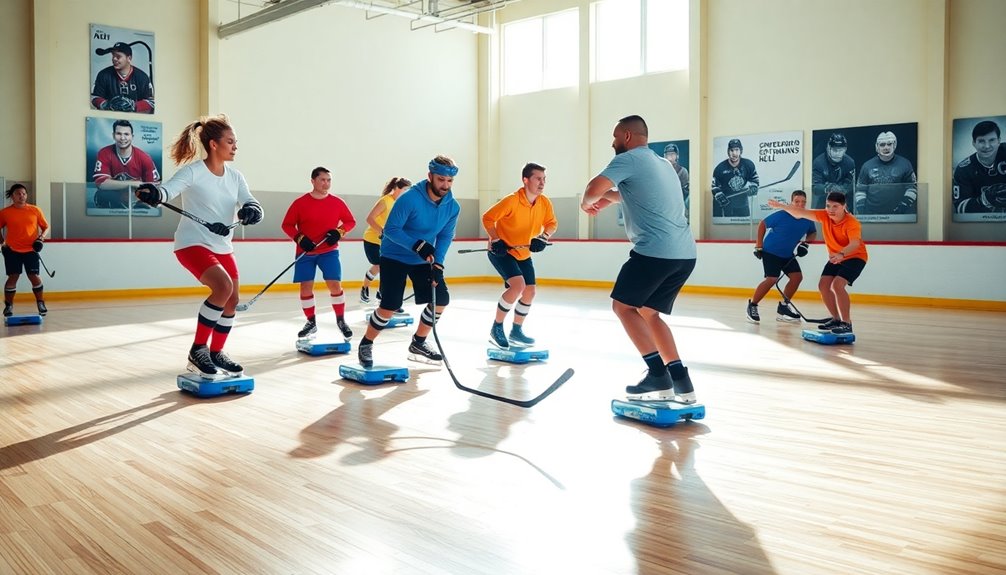
Effective recovery techniques are essential for athletes aiming to maximize their performance and longevity in the sport. Prioritizing quality sleep is critical; aim for 7-9 hours each night to aid muscle recovery and skill retention.
After intense workouts, incorporate active recovery techniques like light aerobic exercises and dynamic stretching to boost blood flow and reduce muscle soreness.
Don't overlook foam rolling and self-myofascial release. Including these in your routine helps alleviate muscle tightness and enhances flexibility, promoting overall recovery.
Proper hydration is another key element. After training, make sure you consume at least 16-24 ounces of water for every pound lost, helping to restore fluid balance.
Nutrition plays an important role, too. Focus on consuming protein and carbohydrates within 30 minutes post-workout to support muscle repair and replenish glycogen stores.
These recovery techniques, when combined, create a solid foundation for your training regimen. By incorporating these strategies, you'll not only enhance your recovery but also set yourself up for improved performance in your off-ice hockey training and beyond.
Common Training Mistakes
When you skip recovery time, you risk overtraining and burnout, which can seriously undermine your performance on the ice.
Plus, ignoring your nutrition needs can leave you lacking the energy and strength required for effective training.
It's essential to prioritize both recovery and proper nutrition to maximize your off-ice training results.
Neglecting Recovery Time
Neglecting recovery time is a common mistake many hockey players make, often in pursuit of improvement. Skipping rest days can lead to serious consequences, including:
- Increased injury risk by up to 50% due to overtraining.
- Compromised quality of sleep, affecting muscle recovery and cognitive performance.
- Decreased muscle repair and growth, hindering your training gains.
- Persistent fatigue and burnout, reducing your motivation and enjoyment of the sport.
Incorporating recovery into your training schedule is vital. Research shows that muscle repair mainly occurs during recovery periods, making it essential for peak performance.
When you prioritize rest, you're not just avoiding injury—you're enhancing your strength and conditioning. Athletes who integrate recovery strategies, like active rest, can see performance improvements of up to 20%.
Ignoring Nutrition Needs
Many hockey players overlook their nutrition needs, which can seriously undermine their training efforts and game performance. When you neglect proper nutrition, you risk decreased energy levels, making it tough to perform at your best during training and games.
Consuming processed foods high in sugars and unhealthy fats can hinder your recovery and muscle growth, directly impacting your overall athletic performance.
To support your intense training, you should focus on a balanced diet rich in whole foods like fruits, vegetables, lean proteins, and whole grains. These foods help maintain ideal body composition and fuel your workouts.
Don't forget about hydration; it's easy to overlook, but inadequate water intake can reduce physical performance and increase the risk of cramps. Aim for at least 8 cups of water daily, especially on workout days.
Additionally, pay attention to nutrient timing. Failing to eat post-workout recovery meals that include carbohydrates and protein can delay muscle repair and adaptation, negatively affecting your training progress.
Prioritizing your nutrition is essential for maximizing your off-ice training and enhancing your on-ice performance.
Seasonal Training Adjustments
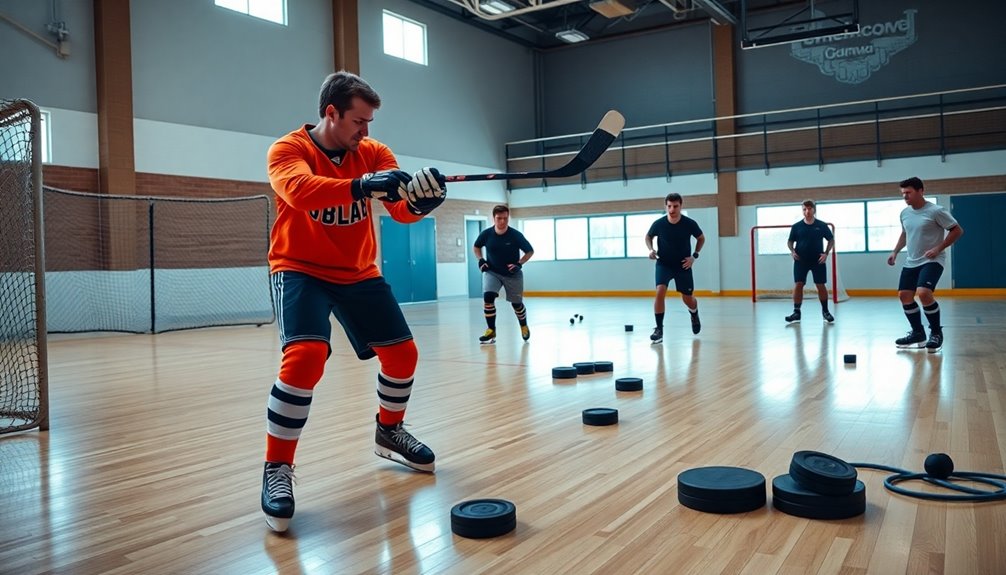
Adjusting your off-ice training as you shift from the off-season to in-season is essential for maintaining peak performance.
Seasonal training adjustments help you stay strong and agile while minimizing the risk of injury. Here are four key aspects to take into account:
- Focus on Recovery: Prioritize recovery techniques to guarantee your body isn't overstressed. This means reducing workout durations to about 60 minutes and limiting volume.
- Modify Training Techniques: In the off-season, you might use eccentric and isometric holds, but during the season, pivot to mobility work and lighter weights to preserve muscle fibers.
- Implement the NP3 Method: This method emphasizes neurological preservation, using pre-fatigue techniques that keep muscle engagement without the risk of burnout.
- Regular Evaluations: Consistently assess your training program as you change over to verify you maintain strength and conditioning without compromising on-ice performance.
Enhancing Speed and Agility
Speed and agility are essential for any hockey player looking to excel on the ice. To enhance your speed and agility, you should incorporate plyometric exercises like box jumps and lateral bounds into your training routine. These exercises boost explosive power, which directly translates to quicker starts and stops during gameplay.
Agility ladder drills, including quick feet and lateral shuffles, are also vital—they increase your coordination and foot speed, allowing for rapid changes in direction.
Incorporate sprint intervals, such as 20-yard sprints with short recovery periods, to mimic the game's stop-and-go nature. This will develop your anaerobic conditioning and acceleration. Additionally, using resistance bands or weighted vests during agility drills can challenge your muscles further, promoting strength gains that enhance your on-ice performance.
Don't forget to practice skating-specific movements, like skater hops and lateral lunges. These exercises reinforce muscle memory and improve your quickness and lateral movement efficiency.
Building Mental Toughness
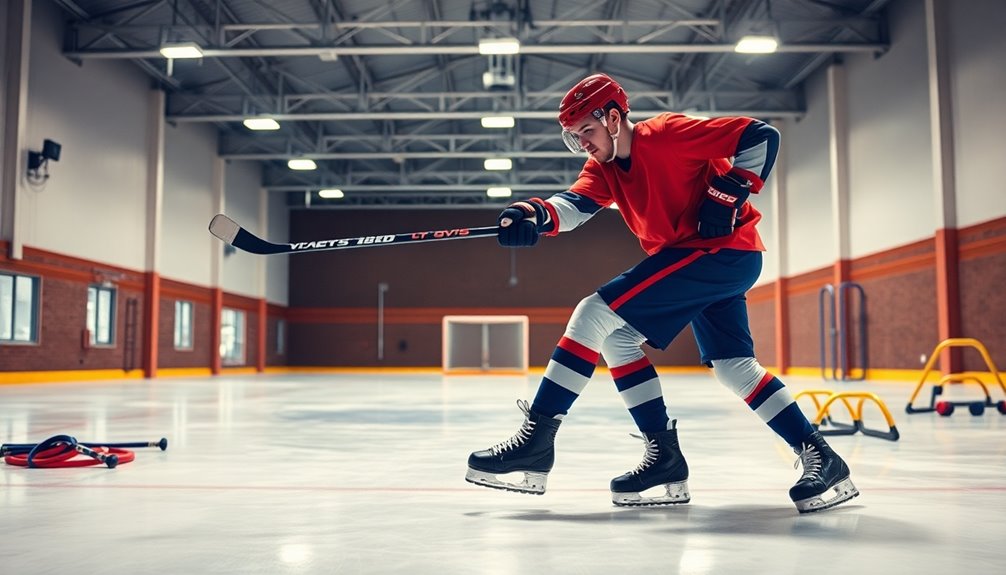
Mental toughness is a critical asset for any hockey player aiming to perform at their best. To build this essential quality, consider incorporating the following techniques into your off-ice training:
- Visualization: Mentally rehearse successful outcomes and game scenarios to boost your confidence and performance.
- Goal Setting: Establish SMART goals—specific, measurable, attainable, relevant, and time-bound—to keep yourself motivated and focused.
- Mindfulness Practices: Engage in meditation and breathing exercises to reduce anxiety and improve concentration, especially under pressure.
- Self-Assessment: Regularly reflect on your strengths and weaknesses to foster resilience and a growth mindset.
Conclusion
By incorporating off-ice training into your routine, you can boost your performance and stay ahead of the competition. Did you know that athletes who engage in regular off-ice training can improve their on-ice speed by up to 20%? This statistic highlights the importance of maintaining your conditioning year-round. So, stay committed to your training program, embrace the techniques outlined, and watch your skills elevate. Remember, consistency is key to achieving your hockey goals!

